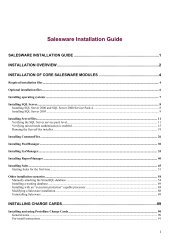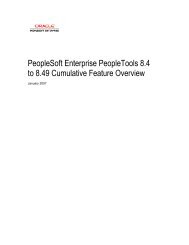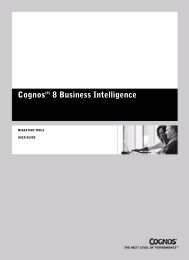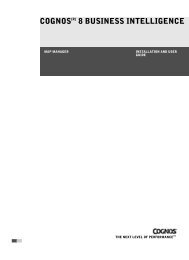COGNOS Business Intelligence Series 7
pes.pdf
pes.pdf
You also want an ePaper? Increase the reach of your titles
YUMPU automatically turns print PDFs into web optimized ePapers that Google loves.
Chapter 6: Audit Server Activity<br />
A typical command line contains the following entries.<br />
Command Line<br />
Argument<br />
-dbname<br />
-dbconnect<br />
-dbuser<br />
-dbpass<br />
-auditlocation<br />
-errorlog<br />
-nbrows<br />
-exitonerror<br />
Description<br />
The database name.<br />
The database connection string that contains the database type and<br />
connection information.<br />
Copy all the text in the connection string after the equal sign (=) from<br />
the Connection Tab in Access Manager - Administration and enclose<br />
it in double quotes. For more information, see "Set Up a Connection<br />
String to the Audit Database" (p. 73)<br />
A database user name with read and write access to the database.<br />
The password for the database user name.<br />
The location of the generated audit log files, usually the installation<br />
location\cern\ppserver folder.<br />
The name of the log file.<br />
The number or rows processed for each transaction.<br />
Stop processing when an error occurs.<br />
Example<br />
In the following example, audit data is transferred to an Oracle data source.<br />
C:\cd Program Files\Cognos\cer4\bin<br />
C:\Program Files\Cognos\cer4\bin\PPESAuditFileProcessor -dbname<br />
OracleDataSource -dbconnect "^UserID:^<br />
?Password:;LOCAL;OR;ORACLE@%s@cyborg/%s" -dbuser Admin -dbpass AdminPW<br />
-auditlocation C:\Program Files\Cognos\cer4\ppserver<br />
Use the Sample Audit Reports<br />
Rather than creating an Impromptu catalog from scratch, you can use the sample audit catalog<br />
provided with PowerPlay Enterprise Server to query the audit database. Using the catalog means<br />
that you must have access to a computer that has Impromptu installed on it.<br />
Steps<br />
1. Open Impromptu.<br />
2. From the Catalog menu, click Open.<br />
3. Locate the PPES.cat file and double-click it.<br />
By default, the PPES.cat file is installed in the<br />
installation location\cern\samples\ppwb\audit folder.<br />
4. From the File menu, click Open and go to installation location\cern\samples\ppwb\audit<br />
folder.<br />
5. Select the report that you want to view.<br />
Understand the Sample Audit Reports<br />
The following is a list of the sample reports included with PowerPlay Enterprise Server. You can<br />
run the sample audit reports from the Impromptu client, or you can publish the reports and run<br />
them on the Web.<br />
74 Cognos PowerPlay (R)
















